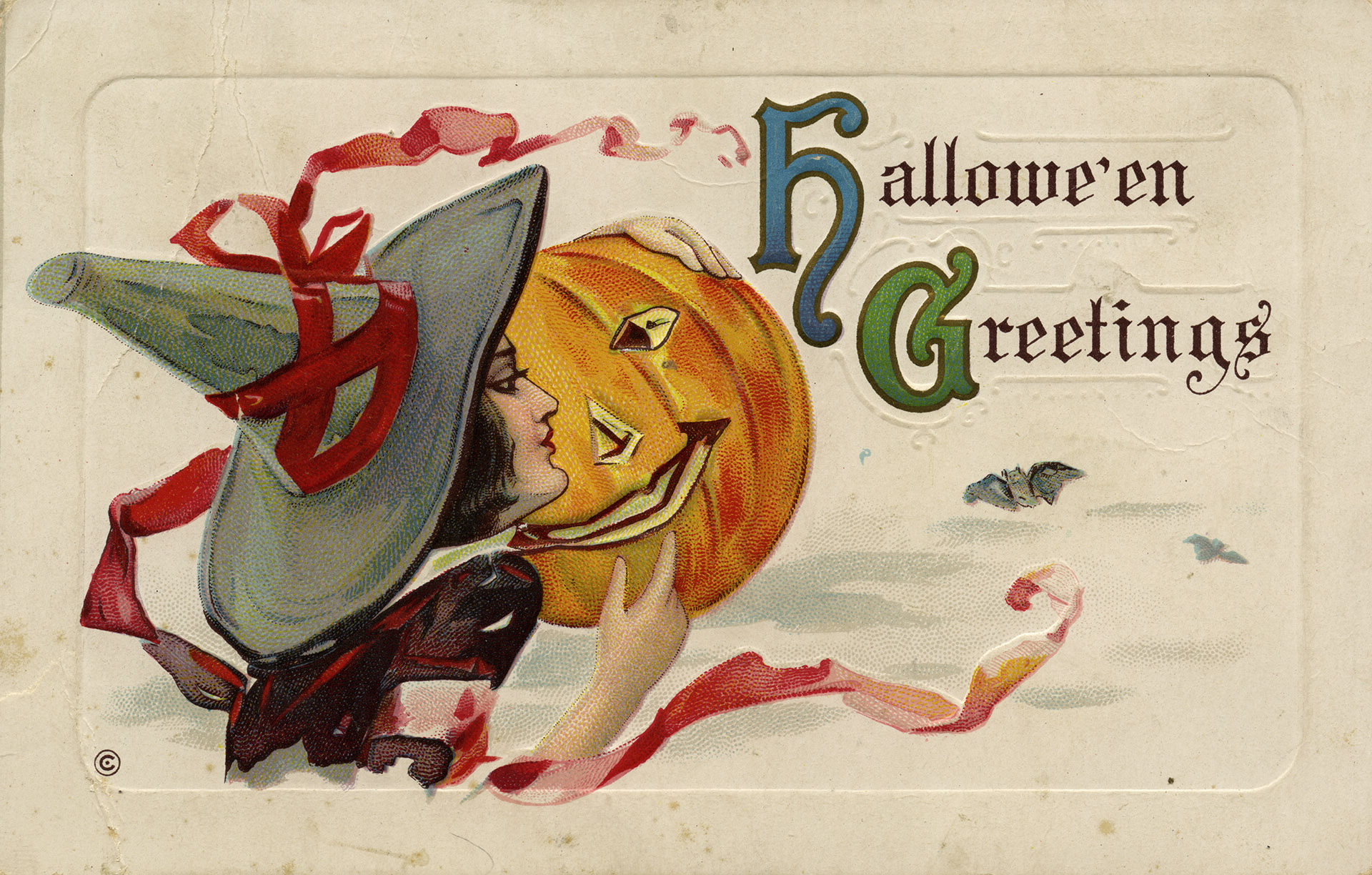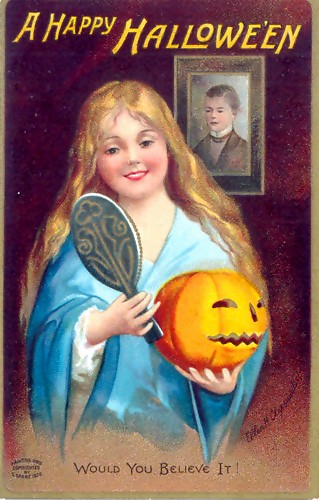Halloween card on:
[Wikipedia]
[Google]
[Amazon]
 A Halloween card is a
A Halloween card is a
 An early reference to a Halloween card is made in volume 4 of ''Ingall's Home and Art Magazine'' published in 1891, in which a sample design is depicted in the article ''Domestic Helps for the Home'' by Laura Willis Lathrop. Early Halloween cards typically depicted the same themes as
An early reference to a Halloween card is made in volume 4 of ''Ingall's Home and Art Magazine'' published in 1891, in which a sample design is depicted in the article ''Domestic Helps for the Home'' by Laura Willis Lathrop. Early Halloween cards typically depicted the same themes as
 Well-known early postcard printers include Winsch and
Well-known early postcard printers include Winsch and
 A Halloween card is a
A Halloween card is a greeting card
A greeting card is a piece of card stock, usually with an illustration or photo, made of high quality paper featuring an expression of friendship or other sentiment. Although greeting cards are usually given on special occasions such as birthdays ...
associated with Halloween. The concept originated in the 1890s United States
The United States of America (U.S.A. or USA), commonly known as the United States (U.S. or US) or America, is a country primarily located in North America. It consists of 50 states, a federal district, five major unincorporated territori ...
, experiencing a peak of popularity there in the early 1900s. Until the advent of the common home telephone, Halloween cards occupied a role similar to Christmas card
A Christmas card is a greeting card sent as part of the traditional celebration of Christmas in order to convey between people a range of sentiments related to Christmastide and the holiday season. Christmas cards are usually exchanged during ...
s and birthday card
A birthday card is a greeting card given or sent to a person to celebrate their birthday. Similar to a birthday cake, birthday card traditions vary by culture but the origin of birthday cards is unclear. The advent of computing and introduction of ...
s. Today, many cards from the popular designers of the period are sought after as memorabilia
A souvenir (), memento, keepsake, or token of remembrance is an object a person acquires for the memories the owner associates with it. A souvenir can be any object that can be collected or purchased and transported home by the traveler as a m ...
.
History
 An early reference to a Halloween card is made in volume 4 of ''Ingall's Home and Art Magazine'' published in 1891, in which a sample design is depicted in the article ''Domestic Helps for the Home'' by Laura Willis Lathrop. Early Halloween cards typically depicted the same themes as
An early reference to a Halloween card is made in volume 4 of ''Ingall's Home and Art Magazine'' published in 1891, in which a sample design is depicted in the article ''Domestic Helps for the Home'' by Laura Willis Lathrop. Early Halloween cards typically depicted the same themes as Easter cards
Easter postcards are a form of postcard that people send to each other at Easter. They have now mostly changed to e-cards rather than postcards, but their purpose remains the same.
History
The tradition of sending Easter postcards to relatives ...
and Christmas card
A Christmas card is a greeting card sent as part of the traditional celebration of Christmas in order to convey between people a range of sentiments related to Christmastide and the holiday season. Christmas cards are usually exchanged during ...
s, as publishers reused images for various holidays, with the caption signifying the specific holiday. From about 1900 to 1915, the United States experienced a Halloween "postcard craze" that continued the commercialization of the holiday that began in the 1800s. By 1909, the Souvenir Post Card Company of New York City produced 12 Halloween card designs.
The popularity of Halloween cards rivaled that of Christmas card
A Christmas card is a greeting card sent as part of the traditional celebration of Christmas in order to convey between people a range of sentiments related to Christmastide and the holiday season. Christmas cards are usually exchanged during ...
s until about 1930, by which time telephone
A telephone is a telecommunications device that permits two or more users to conduct a conversation when they are too far apart to be easily heard directly. A telephone converts sound, typically and most efficiently the human voice, into e ...
s were common household items and began supplanting the use of greeting cards. Halloween-themed postal cards were sold in post office
A post office is a public facility and a retailer that provides mail services, such as accepting letters and parcels, providing post office boxes, and selling postage stamps, packaging, and stationery. Post offices may offer additional ser ...
s and by private printers with displays in general stores. Their popularity and the holiday's commercial success was "ultimately determined" by women, particularly those in the middle class
The middle class refers to a class of people in the middle of a social hierarchy, often defined by occupation, income, education, or social status. The term has historically been associated with modernity, capitalism and political debate. Com ...
.
Of the over 3,000 cards produced in the United States during this period, many depicted themes common to the modern tradition, including witch
Witchcraft traditionally means the use of magic or supernatural powers to harm others. A practitioner is a witch. In medieval and early modern Europe, where the term originated, accused witches were usually women who were believed to have us ...
es, pumpkins, and goblin
A goblin is a small, grotesque, monstrous creature that appears in the folklore of multiple European cultures. First attested in stories from the Middle Ages, they are ascribed conflicting abilities, temperaments, and appearances depending on ...
s. Other Halloween postcard themes included fortune-telling
Fortune telling is the practice of predicting information about a person's life. Melton, J. Gordon. (2008). ''The Encyclopedia of Religious Phenomena''. Visible Ink Press. pp. 115-116. The scope of fortune telling is in principle identical wi ...
and romance or courtship. Designs also reflected the racism in the United States
Racism in the United States comprises negative attitudes and views on race or ethnicity which are related to each other, are held by various people and groups in the United States, and have been reflected in discriminatory laws, practices and ...
of the era: of the postcards produced by the Rust Craft Greeting Card Company
The Rust Craft Greeting Card Company was an American greeting card, printing company and owner of television stations.
The company
The company was founded in a bookstore in Kansas City, Missouri, in 1906 by its owner, Fred Winslow Rust. The compa ...
from 1927 to 1959 catalogued by Wendy Morris, twelve categories of ethnic imagery were identified. The most common theme being black children, appearing on 42% of cards depicting an ethnic or racial difference from the white majority.
Designers
 Well-known early postcard printers include Winsch and
Well-known early postcard printers include Winsch and Raphael Tuck & Sons
Raphael Tuck & Sons was a business started by Raphael Tuck and his wife in Bishopsgate in the City of London in October 1866,Picture Postcards and Their Publishers, by Anthony Byatt, page 288 selling pictures and greeting cards, and eventually se ...
. Both printers employed artists whose postcard designs are collectable
A collectable (collectible or collector's item) is any object regarded as being of value or interest to a collector. Collectable items are not necessarily monetarily valuable or uncommon. There are numerous types of collectables and terms ...
s sought by Halloween memorabilia collectors. Winsch works by Samuel Schmucker (described as "small masterpieces of art nouveau" by Lisa Morton in her book ''The Halloween Encyclopedia'') and Jason Freixas are highly prized. Among the artists employed by Tuck were Francis Brundage, and the "queen of postcard artists", Ellen Clapsaddle.
Notes
References
Sources
* * * * *External links
* {{Halloween Halloween Greeting cards